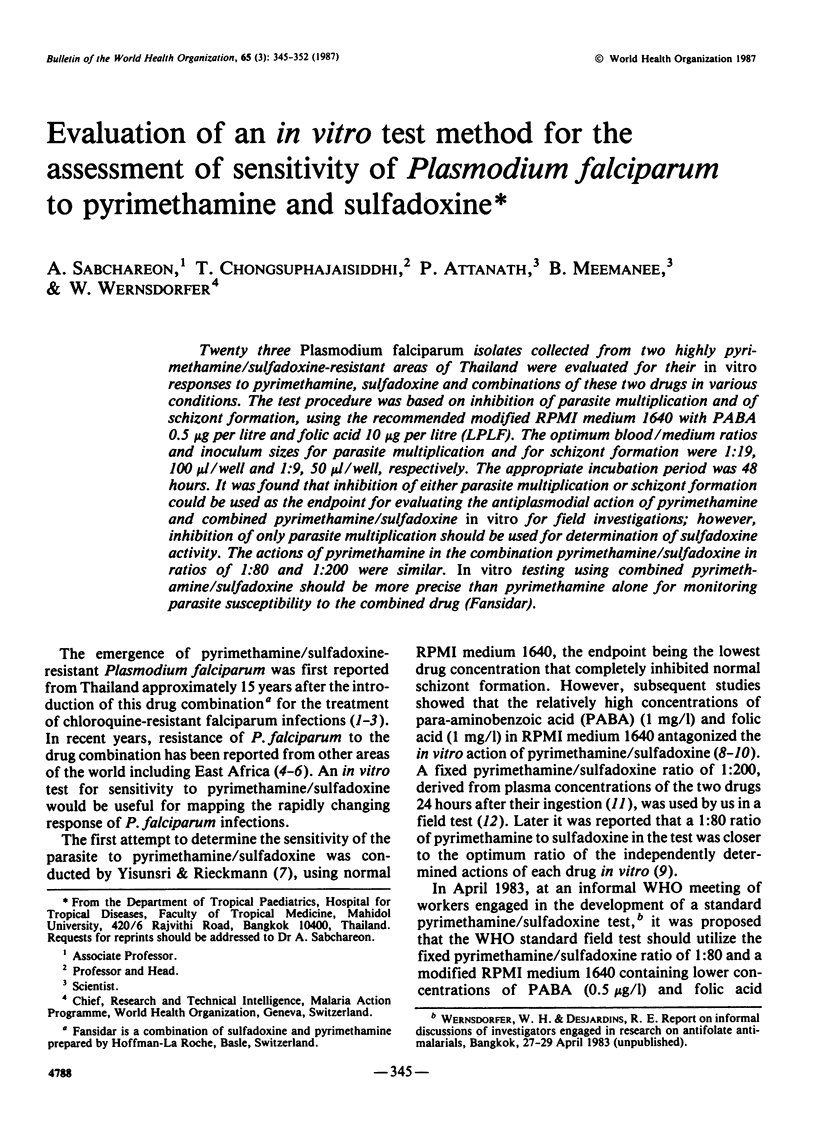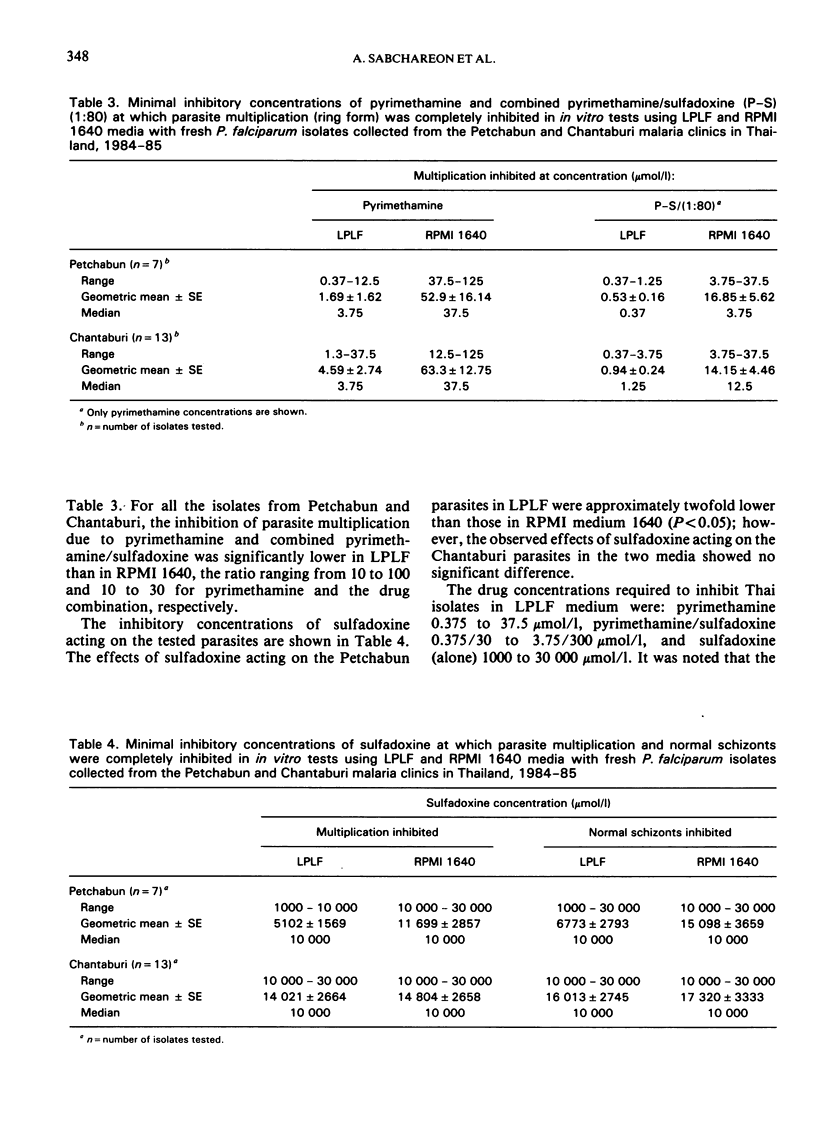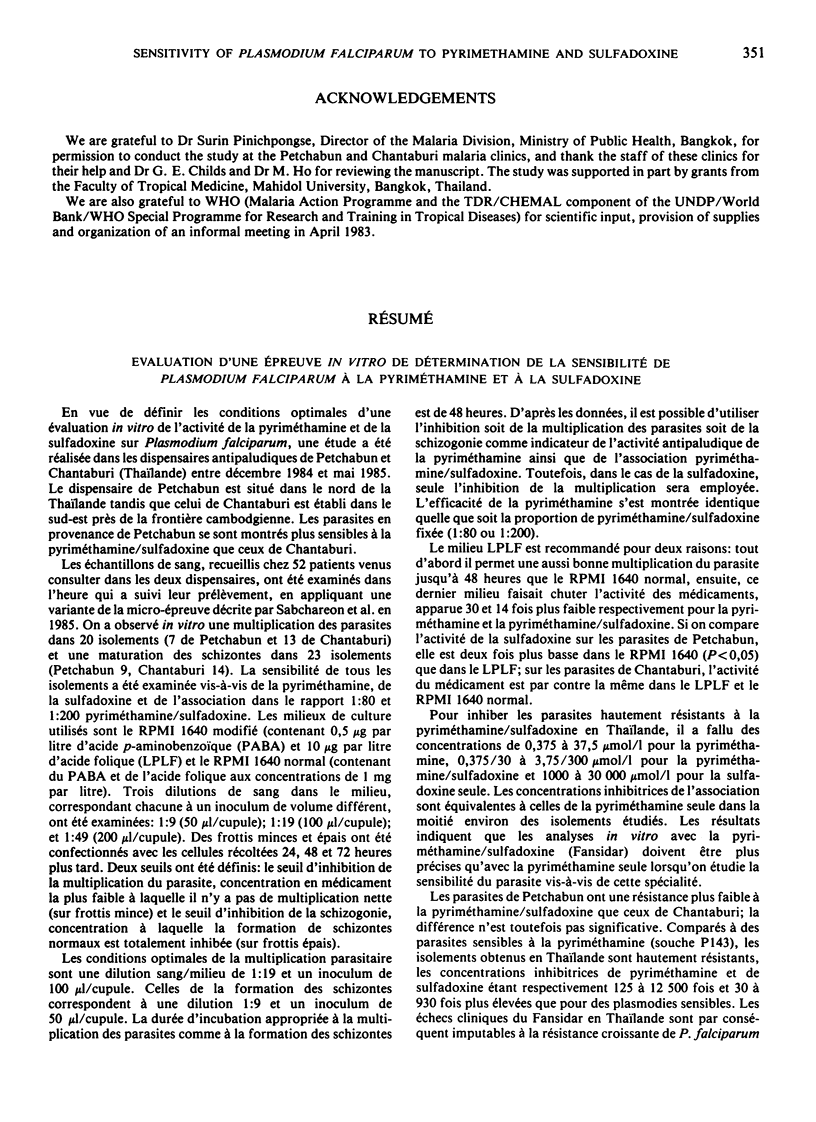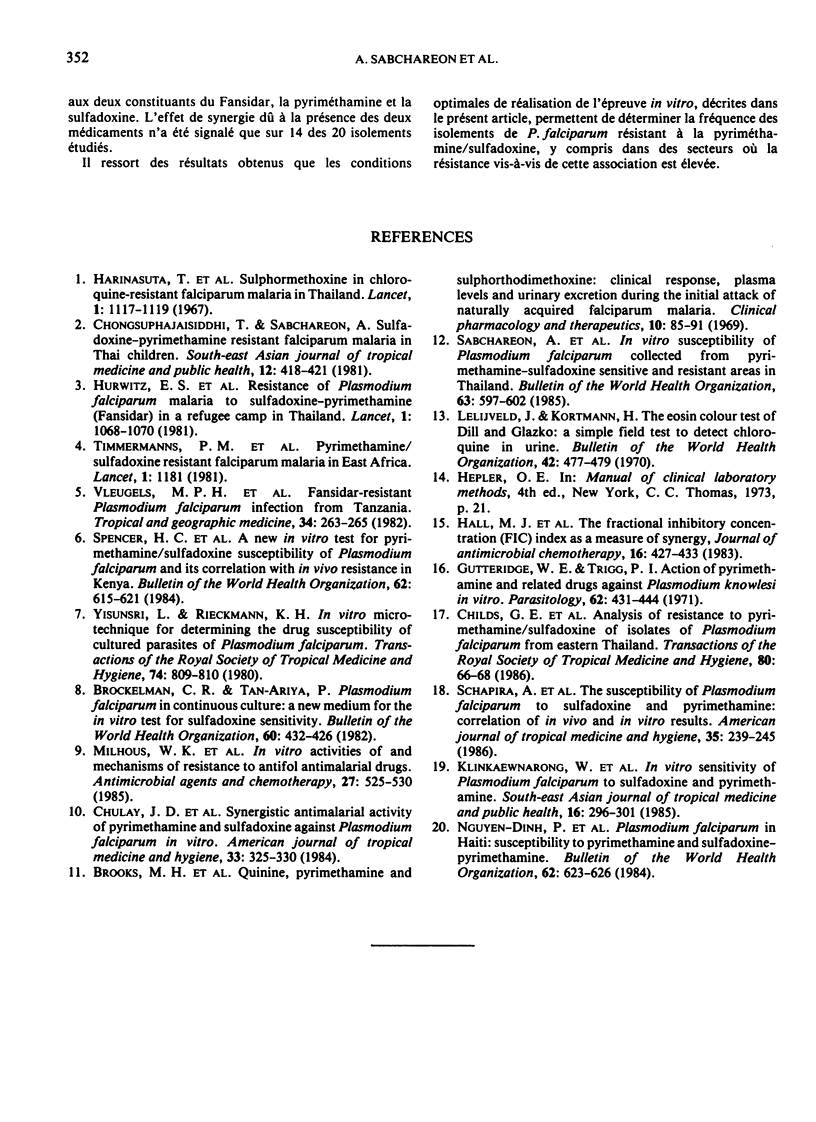Abstract
Twenty three Plasmodium falciparum isolates collected from two highly pyrimethamine/sulfadoxine-resistant areas of Thailand were evaluated for their in vitro responses to pyrimethamine, sulfadoxine and combinations of these two drugs in various conditions. The test procedure was based on inhibition of parasite multiplication and of schizont formation, using the recommended modified RPMI medium 1640 with PABA 0.5 μg per litre and folic acid 10 μg per litre (LPLF). The optimum blood/medium ratios and inoculum sizes for parasite multiplication and for schizont formation were 1:19, 100 μl/well and 1:9, 50 μl/well, respectively. The appropriate incubation period was 48 hours. It was found that inhibition of either parasite multiplication or schizont formation could be used as the endpoint for evaluating the antiplasmodial action of pyrimethamine and combined pyrimethamine/sulfadoxine in vitro for field investigations; however, inhibition of only parasite multiplication should be used for determination of sulfadoxine activity. The actions of pyrimethamine in the combination pyrimethamine/sulfadoxine in ratios of 1:80 and 1:200 were similar. In vitro testing using combined pyrimethamine/sulfadoxine should be more precise than pyrimethamine alone for monitoring parasite susceptibility to the combined drug (Fansidar).
Full text
PDF







Selected References
These references are in PubMed. This may not be the complete list of references from this article.
- Brockelman C. R., Tan-ariya P. Plasmodium falciparum in continuous culture: a new medium for the in vitro test for sulfadoxine sensitivity. Bull World Health Organ. 1982;60(3):423–426. [PMC free article] [PubMed] [Google Scholar]
- Brooks M. H., Malloy J. P., Bartelloni P. J., Sheehy T. W., Barry K. G. Quinine, pyrimethamine, and sulphorthodimethoxine: clinical response, plasma levels, and urinary excretion during the initial attack of naturally acquired falciparum malaria. Clin Pharmacol Ther. 1969 Jan-Feb;10(1):85–91. doi: 10.1002/cpt196910185. [DOI] [PubMed] [Google Scholar]
- Chongsuphajaisiddhi T., Sabchareon A. Sulfadoxine-pyrimethamine resistant falciparum malaria in Thai children. Southeast Asian J Trop Med Public Health. 1981 Sep;12(3):418–421. [PubMed] [Google Scholar]
- Chulay J. D., Watkins W. M., Sixsmith D. G. Synergistic antimalarial activity of pyrimethamine and sulfadoxine against Plasmodium falciparum in vitro. Am J Trop Med Hyg. 1984 May;33(3):325–330. doi: 10.4269/ajtmh.1984.33.325. [DOI] [PubMed] [Google Scholar]
- Gutteridge W. E., Trigg P. I. Action of pyrimethamine and related drugs against Plasmodium knowlesi in vitr. Parasitology. 1971 Jun;62(3):431–444. doi: 10.1017/s0031182000077581. [DOI] [PubMed] [Google Scholar]
- Harinasuta T., Viravan C., Reid H. A. Sulphormethoxine in chloroquine-resistant falciparum malaria in Thailand. Lancet. 1967 May 27;1(7500):1117–1119. doi: 10.1016/s0140-6736(67)91703-5. [DOI] [PubMed] [Google Scholar]
- Hurwitz E. S., Johnson D., Campbell C. C. Resistance of Plasmodium falciparum malaria to sulfadoxine-pyrimethamine ('Fansidar') in a refugee camp in Thailand. Lancet. 1981 May 16;1(8229):1068–1070. doi: 10.1016/s0140-6736(81)92239-x. [DOI] [PubMed] [Google Scholar]
- Klinkaewnarong W., Chongsuphajaisiddhi T., Sabchareon A., Brockelman C. R. In vitro sensitivity of Plasmodium falciparum to sulfadoxine and pyrimethamine. Southeast Asian J Trop Med Public Health. 1985 Jun;16(2):296–301. [PubMed] [Google Scholar]
- Lelijveld J., Kortmann H. The eosin colour test of Dill and Glazko: a simple field test to detect chloroquine in urine. Bull World Health Organ. 1970;42(3):477–479. [PMC free article] [PubMed] [Google Scholar]
- Milhous W. K., Weatherly N. F., Bowdre J. H., Desjardins R. E. In vitro activities of and mechanisms of resistance to antifol antimalarial drugs. Antimicrob Agents Chemother. 1985 Apr;27(4):525–530. doi: 10.1128/aac.27.4.525. [DOI] [PMC free article] [PubMed] [Google Scholar]
- Nguyen-Dinh P., Zevallos-Ipenza A., Magloire R. Plasmodium falciparum in Haiti: susceptibility to pyrimethamine and sulfadoxine-pyrimethamine. Bull World Health Organ. 1984;62(4):623–626. [PMC free article] [PubMed] [Google Scholar]
- Sabchareon A., Chongsuphajaisiddhi T., Attanath P., Kanjanapipatkul K., Doberstyn E. B., Suebsaeng L. In vitro susceptibility of Plasmodium falciparum collected from pyrimethamine-sulfadoxine sensitive and resistant areas in Thailand. Bull World Health Organ. 1985;63(3):597–602. [PMC free article] [PubMed] [Google Scholar]
- Schapira A., Bygbjerg I. C., Jepsen S., Flachs H., Bentzon M. W. The susceptibility of Plasmodium falciparum to sulfadoxine and pyrimethamine: correlation of in vivo and in vitro results. Am J Trop Med Hyg. 1986 Mar;35(2):239–245. doi: 10.4269/ajtmh.1986.35.239. [DOI] [PubMed] [Google Scholar]
- Spencer H. C., Watkins W. M., Sixsmith D. G., Koech D. K., Chulay J. D. A new in vitro test for pyrimethamine/sulfadoxine susceptibility of Plasmodium falciparum and its correlation with in vivo resistance in Kenya. Bull World Health Organ. 1984;62(4):615–621. [PMC free article] [PubMed] [Google Scholar]
- Timmermanns P. M., Hess U., Jones M. E. Pyrimethamine/sulfadoxine resistant falciparum malaria in East Africa. Lancet. 1982 May 22;1(8282):1181–1181. doi: 10.1016/s0140-6736(82)92243-7. [DOI] [PubMed] [Google Scholar]
- Vleugels M. P., Wetsteyn J. C., Meuwissen J. H. Fansidar-resistant Plasmodium falciparum infection from Tanzania. Trop Geogr Med. 1982;34(3):263–265. [PubMed] [Google Scholar]
- Yisunsri L., Rieckmann K. In vitro microtechnique for determining the drug susceptibility of cultured parasites of Plasmodium falciparum. Trans R Soc Trop Med Hyg. 1980;74(6):809–810. doi: 10.1016/0035-9203(80)90210-2. [DOI] [PubMed] [Google Scholar]


